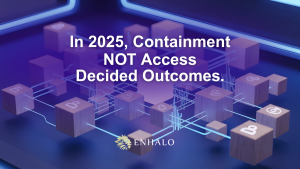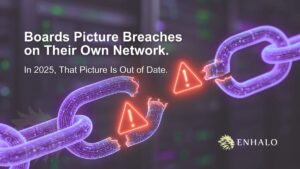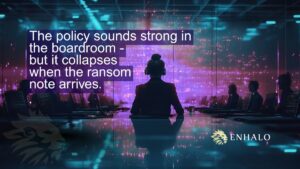A company’s cybersecurity posture is as crucial as its physical security. With cyber threats evolving daily, it’s easy to assume that the Chief Information Security Officer (CISO) would aim to eliminate every possible risk. However, this is far from the truth. Just like other business leaders, CISOs operate with budgetary constraints and must make crucial decisions to protect the business without stymieing its growth.

1. Prioritizing Threats Over Absolute Security
Given the dynamic nature of cybersecurity threats, achieving absolute security is a near-impossible task. Thus, CISOs focus on the most severe threats that can disrupt operations. It’s a strategy of prioritization over perfection, understanding that resources are finite and should be directed where they can deliver the most value.
What’s at stake? The value of the most critical assets at risk – it might be customer data, intellectual property, or financial details. Additionally, the industry-specific compliance requirements an organization falls under can dictate priority. Failing to meet these requirements can lead to hefty fines or reputational damage.
2. Business Growth and Cybersecurity: Striking a Balance
A robust cybersecurity strategy should not act as a roadblock to business operations. CISOs work diligently to ensure that security measures do not impede other departments, especially those directly responsible for revenue generation. After all, while a completely locked-down system might be “secure,” if it prevents teams from functioning efficiently, it could be detrimental to the company’s bottom line.
3. Collaborative Decision Making
A well-rounded cybersecurity approach thrives on collaboration. CISOs regularly engage with other business stakeholders to understand operational needs and ensure that security measures align with business objectives. Working closely with the finance department to understand budget constraints ensures aligning security initiatives with the organization’s overall financial goals while considering the potential impact of cyber threats on the organization’s bottom line. Collaboration with the legal department ensures that potential compliance breaches are prioritised and addressed promptly.
This iterative dialogue ensures that as the business grows and evolves, the cybersecurity approach does, too, in a manner that supports and safeguards the company’s interests.
4. Cost-Effective Security
While investing in the latest and greatest security tools might be tempting, CISOs recognize the importance of cost-effective security solutions. They continually evaluate the ROI of security investments, ensuring the company gets the best protection for its buck.
5. Championing Continuous Learning
Minimizing risk often starts with the employees. In collaboration with the human resources department, CISOs often champion training programs that help staff recognize and respond to threats. However, they are also pragmatic, understanding that human error is inevitable. Therefore, they prioritize training around the most consequential risks, ensuring that the most dangerous threats are the ones employees are best equipped to handle and report on.
The Role Of The CISO Is A Delicate Balancing Act
Being a CISO isn’t about one-size-fits-all solutions. It is a highly contextual challenge, a delicate balancing act, merging the often-competing worlds of business operations and cybersecurity budget management. Their mission is not to create an impenetrable fortress but to craft a resilient and agile defense that protects the company’s most vital assets.
Beyond Box-Ticking: Real-World Risk Management
Finance CISOs: Guarding Treasure Troves
Banks, investment firms, and financial institutions find themselves perpetually under the cybercriminal microscope. With troves of sensitive customer data, transaction histories, and a digital infrastructure that manages vast sums of money, these entities are a goldmine for hackers. Yet, in the face of these seemingly insurmountable threats, CISOs in the financial sector have crafted remarkably robust defenses:
- Razor-sharp focus on potential impacts
- Threat assessments not just by likelihood but by the potential fallout on organizational stability and the implications for regulatory compliance
- Advanced analytics and real-time threat intelligence employment to ensure they’re not fighting yesterday’s battles
- Finite resources channeling into thwarting the most catastrophic threats, preserving both trust and bottom lines
In 2014, JPMorgan Chase, one of the biggest financial institutions globally, experienced a breach where data associated with over 83 million accounts were compromised. Post-incident CISO and his team had to focus on plugging the security loophole and ensuring the bank’s operational stability, and fulfilling regulatory compliance requirements.
Healthcare CISOs: Where Care Meets Confidentiality
The healthcare sector is a unique beast. On the one hand, there’s an ever-growing database of deeply personal, sensitive patient data. On the other, there’s a need for unfettered access to this data to ensure timely and effective patient care. The fallout of a cyber breach in healthcare isn’t just about data – it can jeopardise lives.
CISOs in this space grapple with this delicate balance daily by:
- Giving precedence to risks that could lead to data breaches or, even worse, disrupt critical patient care pathways
- Creating a hierarchy of risks, streamlining security measures, and ensuring that data remains sacrosanct while not hindering the primary mission of healthcare: saving lives
In 2017, the WannaCry ransomware attack severely impacted the U.K.’s National Health Service (NHS). Multiple hospitals had to turn away non-critical emergencies, rendering patient records inaccessible. The incident highlights the CISOs’ challenge: they had to both safeguard patient data and ensure that the healthcare infrastructure could still function effectively, which is paramount for saving lives.
Manufacturing CISOs: Safeguarding Production’s Pulse
Though often underestimated in terms of cyber risks, the manufacturing sector is a hub of proprietary technology, designs, and operational processes. Production lines and connected devices offer a playground for cyber adversaries seeking to disrupt operations or steal intellectual property.
Here CISOs don’t just aim to protect data; they guard the very heartbeat of production; they:
- Manage challenges revolving around legacy systems, machinery with outdated firmware, and an intricate supplier ecosystem
- Implement strategy with an emphasis on network segmentation, rigorous access controls, and real-time monitoring
- Protect trade secrets
- Ensure uninterrupted production
- Showcase a fine blend of maintaining operational efficiency while warding off potential cyber disruptions
In 2020, a major car manufacturer had to halt production for over a week due to a ransomware attack on its systems. This pause led to significant financial losses and delivery delays. CISOs in manufacturing have to ensure data protection and the smooth functioning of production lines. A critical strategy post-attack involved segmenting networks to protect vital machinery from future threats.
Retail CISOs: Protecting Transactions and Trust
Retailers today, both brick-and-mortar and e-commerce platforms, process an enormous volume of consumer data daily. From credit card information to shopping behaviours and preferences, the retail sector is a treasure trove of data. While one data breach could lead to direct financial losses, tarnishing the brand’s reputation can have long-lasting implications.
For CISOs in retail, the objective is dual-pronged: ensuring transactional security and preserving consumer trust by:
- Leveraging advanced encryption technologies, multi-factor authentication, and continuous monitoring to keep both cyber attackers and consumer doubts at bay
- Gearing cybersecurity towards both proactive defense and rapid incident response, emphasizing transparent communication with consumers in the event of anomalies
In 2013, Target, a massive U.S. retailer, faced a data breach where credit and debit card data of over 40 million customers were stolen. This breach didn’t just result in financial repercussions but significantly eroded consumer trust. The retail giant had to overhaul its security measures, with an emphasis on encryption, multi-factor authentication, and real-time transaction monitoring.
Energy and Utility CISOs: Shielding National Lifelines
The energy and utilities sector is the backbone of nations, supplying essential services like electricity, water, and gas. A cyberattack here isn’t just about data breaches; it could plunge cities into darkness or disrupt critical supply chains.
For CISOs in this domain, the stakes couldn’t be higher. Their role showcases the necessity of cybersecurity measures that protect not just an organization’s assets but, in many ways, a nation’s very way of life by:
- Securing vast infrastructural grids and managing legacy systems often ill-equipped for modern threats
- Prioritizing risks related to critical infrastructure over conventional IT assets
- Employing strategies such as air-gapping, reinforced network perimeters, and meticulous emergency response plans
In 2015, Ukraine experienced a power grid hack that left over 230,000 people without electricity in the dead of winter. This cyberattack wasn’t just an organizational concern but a national security issue. The CISOs in charge had to prioritize securing the IT systems and, more critically, the Operational Technology (OT) systems that directly controlled the electricity supply. A post-incident strategy involved comprehensive network audits, air-gapping critical systems, and implementing reinforced network perimeters.
These real-world examples from the finance, healthcare, manufacturing, retail, and energy sectors underscore the CISOs’ vital and diverse contribution across industries.
It is evident that effective risk management isn’t just about ticking compliance boxes; it’s about understanding the unique challenges of your sector and tailoring your defenses accordingly. It’s a testament to the resilience and ingenuity of CISOs that, even in resource-constrained environments, continue to hold the line, keeping threats at bay.
Cost-effective Security Solutions for CISOs
Security Awareness Training – a well-informed team is your first defense
Multi-Factor Authentication – an extra layer of security, ensuring that even if passwords are compromised, attackers can’t easily gain access
Regular Patching and Updates – ensuring that all software, from operating systems to applications, is regularly updated can protect against known vulnerabilities
Cloud-Based Security Solutions – built-in security features at a fraction of the cost of traditional on-premise solutions, including everything from firewalls to DDoS protection
Incident Response Playbooks – a predefined set of procedures for different types of security incidents can speed up response times, mitigate damage, and reduce long-term costs
Network Segmentation – separating critical assets from the broader network can reduce the risk of a breach spreading, protecting vital systems without a significant financial outlay
Regular Backups – consistent backup regimen can be a lifesaver in the event of ransomware attacks or data corruption







